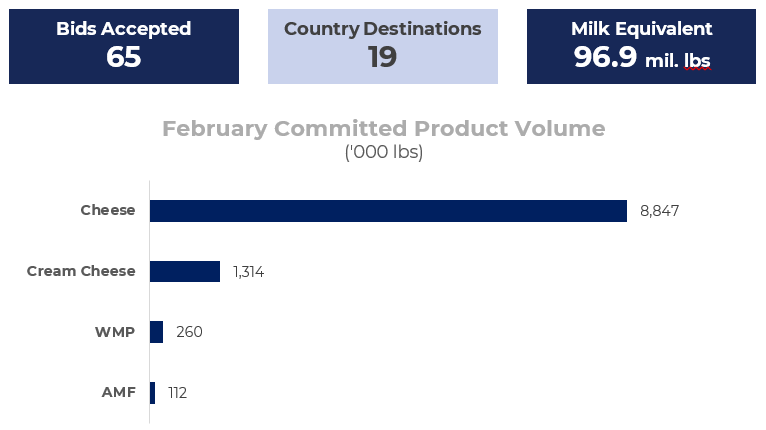This week the arduous process of modernizing the Federal Milk Marketing Order system reached another milestone, with participating organizations submitting their final statements summing up their arguments for why USDA should adopt their proposals as part of a new federal order.
NMPF continues its leadership, offering the most detailed, comprehensive plan to USDA. This process has never been about who has the louder voice. From the very start it has been about putting in the work to understand the purpose and function of federal orders and painstakingly assembled the consensus support and careful approach that any plan needs to succeed.
It’s also because we’ve crafted our plan following principles that align thoroughly with the FMMO mission and purpose. In upcoming weeks, as USDA considers competing proposals, we expect that some of our opponents will attempt to muddy the waters, offering “solutions” that are incompatible with how federal milk marketing orders are meant to function – or, even worse, offering ideas that intentionally undermine core principles of the FMMO system. So, some principles for everyone to keep in mind as USDA moves forward.
The FMMO system is designed and intended to put farmers first. This isn’t just NMPF, the nation’s largest dairy-farmer organization, touting its own interests. It’s the literal legal language of a landmark interpretation of the Agricultural Marketing Agreement Act, which authorizes federal milk marketing orders. Under this statute, the “principal purposes” of the system is “to raise the price of agricultural products and to establish an orderly system for marketing them.” Court language further emphasizes that the law’s purpose is to protect milk producers. Specifically, the “‘essential purpose” of FMMOs is “to raise producer prices” and thus “ensure that the benefits and burdens of the milk market are fairly and proportionately shared by all dairy farmers.”
This principle is fundamental to every other consideration. Any revamp of orders must focus on producers, and it needs to benefit all producers fairly. That’s been the bedrock of our proposals, and its mission is well-served by the balance we’ve achieved.
The FMMO system is meant to encourage the orderly marketing of milk. Emphasizing the need for an “orderly system” – a well-functioning market is meant to benefit both milk producers and consumers. Again, the Agricultural Marketing Agreement Act allowing federal orders is established to “provide, in the interests of producers and consumers, an orderly flow of the supply thereof to market … to avoid unreasonable fluctuations in supplies and prices.”
That’s important to remember when considering approaches to the make-allowance, the Class I price surface, component pricing, and the other parts of our proposal. Along with the first priority of helping farmers, NMPF’s plans ensure an orderly market that serves consumers well without being unduly disruptive of any one component or adding disproportionate hardship to other key actors on the milk marketing system.
Arguments that boil down to “whatever gets me the most money” don’t seriously build consensus. And consensus is a necessity.
NMPF’s proposals for modernization were the most carefully balanced proposals presented at the hearing, but they were only about one-quarter of all proposed amendments to the order. Several competing proposals had some merit, especially from the perspectives of the organizations submitting them. What set our proposals apart was a genuine attempt to make separate pieces work together for the collective benefit of all dairy farmers – other proposals fell short in achieving that.
Even more disappointing were processor-led proposals that had no consistency or principle other than boosting processor bottom lines – a direct contradiction of the FMMO mission. These short-sighted ideas would, in many instances, lead to the unnecessary failure of numerous dairy farms and create disorderly markets.
And following on that, one final observation:
Dragging out modernization any further does nothing to help farmers. Anyone who thinks it doesn’t matter, remember: Farmers first.
Having witnessed the unnecessarily drawn-out hearing in Carmel, IN, it’s hard not to wonder if foot-dragging is a strategic choice in some circles. What’s a few months of million-dollar legal fees when a faulty Class I mover alone has cost farmers $1.2 billion since 2019? Who exactly benefits from a few more months of inaccurate component pricing that ensures farmers aren’t fairly compensated for the quality of their milk?
The original targeted timeline for a modernization vote was set for this fall, but now the spring of 2025 is more likely. Assuming that USDA adopts a plan that’s aligned with the key points above, it’s imperative that the entire dairy community, for the sake of the farmers the FMMO system is designed to serve, support timely approval and implementation. Drawn-out hearing-room banter is one thing – the prosperity of dairy farmers who have waited patiently long enough is more important than profiting from further delay.
Since this effort began in earnest in the wake of the COVID-19 outbreak, NMPF has taken seriously its role as the policy leader for U.S. dairy farmers and the cooperatives they own. We continue to draw on the strength of our members throughout our united effort – that’s the foundation of success. We’ve taken another big step this week. We continue to look forward to its successful conclusion.
Gregg Doud
President & CEO, NMPF







